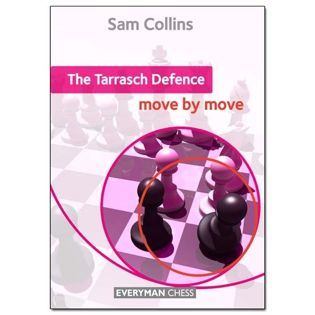Tarrasch Defence — Move by Move, The
Sam Collins

Today the trend is for top professionals to play multiple openings with both colors to sidestep preparation. While this approach may be advisable for them it isnt very realistic for the serious amateur enthusiast who has limited free time to study. This sort of player doesnt want to spend all their leisure hours poring over theory but they do want to get a playable game out of the opening. What to do?
One approach is to specialize. Contrary to the situation for professionals there is little need for amateurs to worry about opening surprises from their opponent. This is definitely the case in the United States where even major tournaments like the World Open see the pairings posted just a few minutes before the round, eliminating the possibility to prepare.
The amateur can save even more study time for other phases of the game by selecting an all-in-one system that provides a cohesive, transpositional friendly repertoire. One opening that fits the bill is the subject of a new book by Irish IM Sam Collins. The Tarrasch Defense: Move by Move covers an answer to every White try but 1.e4. Black takes one potential weakness (an isolated queen pawn) but gains easy development for all his pieces. This classical approach has much to recommend it for the layman and it is a pity that there is nothing quite like it against 1.e4 (the Open variation of the Ruy Lopez might come close).
Those contemplating playing the Tarrasch (or who have played it for awhile) will likely be aware of Jacob Aagaard and Nikolaos Ntirlis book on the Tarrasch published by Quality Chess in 2011. This pioneering work was a true theoretical tour de force with over 100 two columns pages spent on 9…c4 (after 1.d4 d5 2.c4 e6 3.Nc3 c5 4.cxd5 exd5 5.Nf3 Nc6 6.g3 Nf6 7.Bg2 Be7 8.0-0 0-0 9.Bg5). Collins has a much different approach in mind. Whereas the Aagaard/Ntirlis was aimed at the 2300 on up audience, the Irish IM is geared towards players 1800-2300. He offers more explanatory prose and does a very fine job of explaining the ideas and plans behind the Tarrasch. For the average player this is gold.
The Tarrasch Defense: Move by Move offers the reader an overview of the Tarrasch without overwhelming them. For example after 9.Bg5 Collins examines all three black tries (not only 9…c4 but also 9…Be6 and 9…cxd4). The level of detail will be more than sufficient to satisfy all but hard-core professionals, but the material is presented in a way that is accessible to strong club players. It helps that Collins has extensive experience playing the Tarrasch.
This work doesnt just examine the Tarrasch defense via 1.d4 d5 2.c4 e6 3.Nc3 c5 but also covers ways to meet Reti/English move-orders (1.Nf3/1.c4). As a bonus Collins concludes his book with a section on the sharp and dangerous Von Herring-Schara Gambit (1.d4 d5 2.c4 e6 3.Nc3 c5 4.cxd5 cxd4) and the Swedish Variation (1.d4 d5 2.c4 e6 3.Nc3 c5 4.cxd5 exd5 5.Nf3 Nc6 6.g3 c4 7.Bg2 Bb4 8.0-0 Nge7). Both are better than their reputation and could be good surprise weapons.
The Tarrasch Defense: Move by Move will be useful for a wide audience of players looking for a dependable and practical weapon to play against 1.d4 and other closed openings. Like other Everyman Chess titles it is available in both print and electronic formats.
